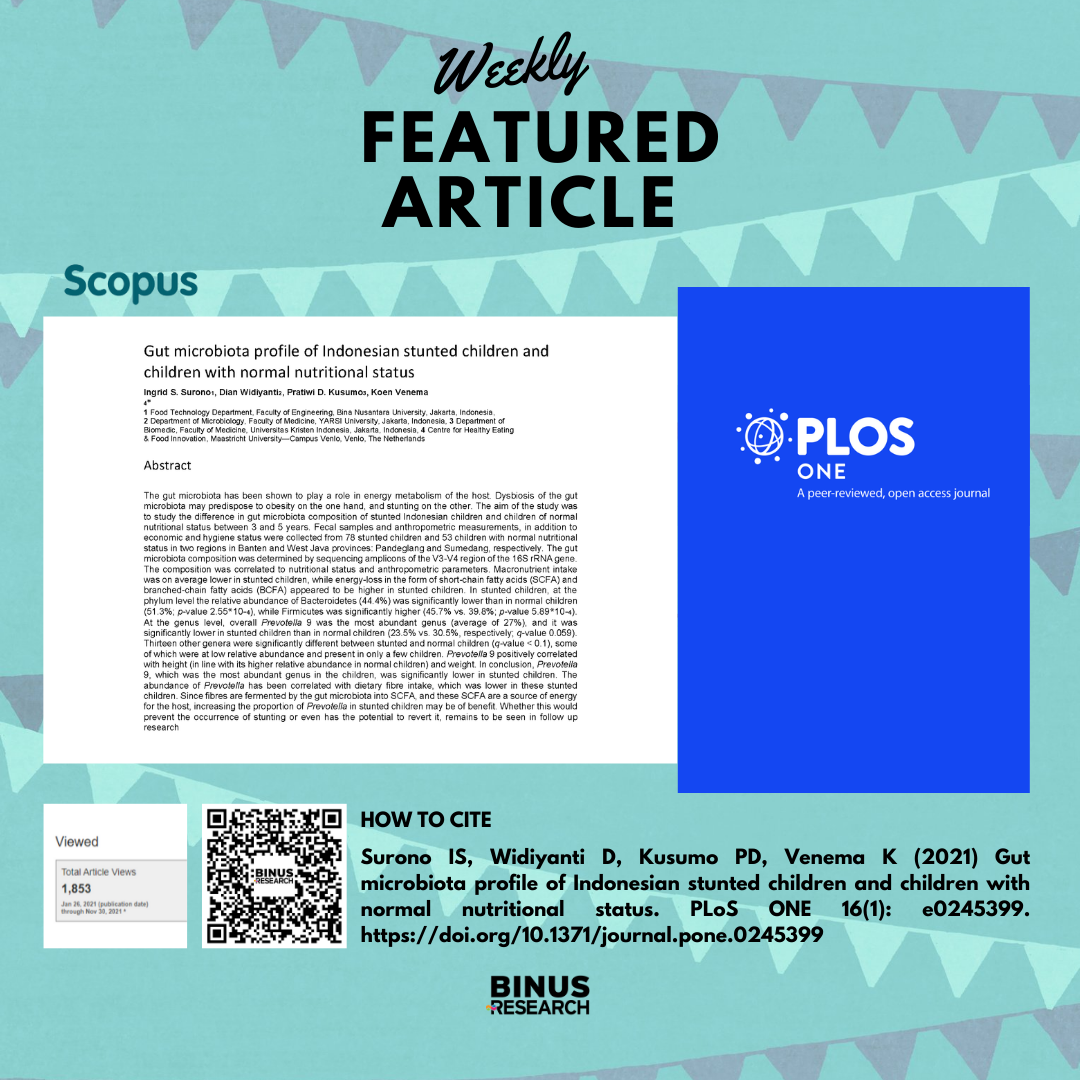Weekly Featured Article

Gut microbiota profile of Indonesian stunted children and children with normal nutritional status
Ingrid S. Surono, Dian Widiyanti, Pratiwi D. Kusumo, Koen VenemaID
Food Technology Department, Faculty of Engineering, Bina Nusantara University, Jakarta, Indonesia; Department of Microbiology, Faculty of Medicine, YARSI University, Jakarta, Indonesia; Department of Biomedic, Faculty of Medicine, Universitas Kristen Indonesia, Jakarta, Indonesia; Centre for Healthy Eating & Food Innovation, Maastricht University—Campus Venlo, Venlo, The Netherlands
Abstract
The gut microbiota has been shown to play a role in energy metabolism of the host. Dysbiosis of the gut microbiota may predispose to obesity on the one hand, and stunting on the other. The aim of the study was to study the difference in gut microbiota composition of stunted Indonesian children and children of normal nutritional status between 3 and 5 years. Fecal samples and anthropometric measurements, in addition to economic and hygiene status were collected from 78 stunted children and 53 children with normal nutritional status in two regions in Banten and West Java provinces: Pandeglang and Sumedang, respectively. The gut microbiota composition was determined by sequencing amplicons of the V3-V4 region of the 16S rRNA gene. The composition was correlated to nutritional status and anthropometric parameters. Macronutrient intake was on average lower in stunted children, while energy-loss in the form of short-chain fatty acids (SCFA) and branched-chain fatty acids (BCFA) appeared to be higher in stunted children. In stunted children, at the phylum level the relative abundance of Bacteroidetes (44.4%) was significantly lower than in normal children (51.3%; p-value 2.55*10−4), while Firmicutes was significantly higher (45.7% vs. 39.8%; p-value 5.89*10−4). At the genus level, overall Prevotella 9 was the most abundant genus (average of 27%), and it was significantly lower in stunted children than in normal children (23.5% vs. 30.5%, respectively; q-value 0.059). Thirteen other genera were significantly different between stunted and normal children (q-value < 0.1), some of which were at low relative abundance and present in only a few children. Prevotella 9 positively correlated with height (in line with its higher relative abundance in normal children) and weight. In conclusion, Prevotella 9, which was the most abundant genus in the children, was significantly lower in stunted children. The abundance of Prevotella has been correlated with dietary fibre intake, which was lower in these stunted children. Since fibres are fermented by the gut microbiota into SCFA, and these SCFA are a source of energy for the host, increasing the proportion of Prevotella in stunted children may be of benefit. Whether this would prevent the occurrence of stunting or even has the potential to revert it, remains to be seen in follow up research
Scan the QR Code to read the article on website
https://journals.plos.org/plosone/article?id=10.1371/journal.pone.0245399
_________________________________
ᴅᴀᴛᴀ ᴀɴᴀʟʏᴛɪᴄ ᴀɴᴅ ᴘᴜʙʟɪᴄ ᴇɴɢᴀɢᴇᴍᴇɴᴛ
??? ?????
https://linktr.ee/binusresearch
#scopus #BINUSUNIVERSITY #BINUSIAN #BINUSRESEARCH #fosteringandempowering


